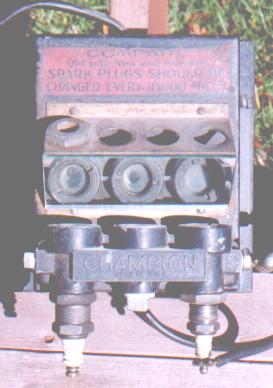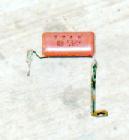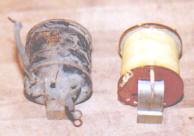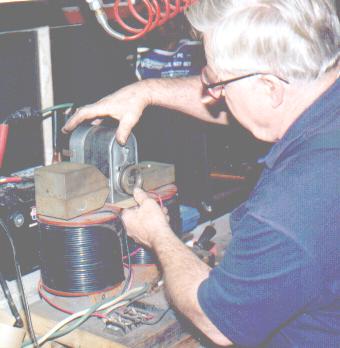Spark plugs, magnetos and oh my aching leg!

That's me checking the internal timing on a Splitdorf
NS magneto
Spark Plugs
While this is not a magneto problem,
they're breakdown symptoms can easily be confused with that of the magneto.
The spark plug is at the end of a rather long chain of events. What
starts out as a simple magnetic field in the magneto is transformed and
amplified into an electrical discharge at the spark plug of over 20,000
volts. The correct spark plug and gap is crucial to proper ignition.
Spark discharge is a breakdown in the air insulator between the electrode
and ground. Yes - air is an insulator, a pretty good one at that.
As voltage builds at the electrode, atoms in the air within the air gap
gain electrons. This process is called ionization. Ionization
turns the air gap into a low resistance path between conductors.
When a spark plug fires under compression, the quality of the spark will
be very different from when it fires under ambient pressure. Barometric
(air) pressure at sea level is approximately 30 lbs. per square inch.
If cylinder compression is 75 psi (measured with a compression gauge),
this is actually 75 psi greater than ambient pressure because the compression
gauge is zeroed at ambient pressure. It is much more difficult for
a spark to jump the gap under higher pressure, because higher pressure
makes the air a better insulator. A plug may throw a strong spark
when held against the side of a cylinder for testing, but when installed
in the cylinder and subjected to an additional 75 lbs. of pressure it may
not. This can be indicative of either a weak magneto or deteriorated
plug wires. It can also be caused by a spark plug's insulation breaking
down. Electricity will always seek the path of least resistance to
ground. If the increased resistance at the air gap caused by high
air pressure is greater than the plug's insulation resistance, the plug
will short to ground and not spark.
Using a spark plug tester - a great way to check
your plugs
How many times have you held a spark plug against a cylinder
head and kicked over the engine to see if you had a spark? Did you
have good spark on the cylinder head, but when the plug was put back in
the head the $#^@ machine still wouldn't fire? Earlier we said that
compression has a significant effect on the spark plug. This brings
us to the question of how to tell if the plug is working properly inside
the cylinder. In the old days many spark plugs were rebuildable.
Champion and others companies developed 
If you've tried the spark plug against
the head test and had a good spark and all other systems (fuel, timing,
rings and valves etc.) seem to be OK, this device may show where the problem
lies. A few years ago I was searching for a set of original, period
Splitdorf Green Jacket spark plugs for my 1916 Indian Powerplus.
I went down to visit a spark plug collector and spent a very enjoyable
afternoon searching through and testing many plugs. After locating
a half-dozen Green Jacket candidates we broke out his dusty old spark plug
tester. Four of the six sparked OK under ambient pressure, but exhibited
little or no spark under 60 lbs. of pressure. The other two would
not spark at all. Since these are rebuildable plugs we first tried taking
them apart for a thorough cleaning. This helped some, but not entirely.
After trying various combinations of cores and bodies, we were getting
nowhere fast. Seeing the look of desperation in my eyes, he said
"wait here". A few minutes later he emerged with two N.O.S Splitdorf
cores. We put them into the best bodies and tried them out.
The result was a nice hot, blue spark at ambient pressure and at 60 psi.
I was in business.
Without a spark plug tester I would
have assumed the plugs that sparked at ambient pressure (laying plug against
the head type test) were good. No doubt I would have kicked and kicked
that motor until my leg throbbed and I was blue in the face without ever
getting it to fire. I'd have continued to believe the plugs were
OK and probably gone off troubleshooting in a different and unnecessary
direction.
These old testers can occasionally
be found at antique auto swap meets or advertised in publications such
as Hemmings Motor News. I was fortunate in finding mine at the AMCA
national meet in Wauseon Ohio about 4 or 5 years ago. It worked good
until recently when the coil finally gave up. Fortunately there are
a few craftsmen in the Model T hobby who restore these coils. I sent
it off with instructions to do whatever it took to put it in working order.
In less than two weeks I had the coil back, restored and adjusted for under
$40.00. My spark plug tester was back in operation. Whenever
I'm having trouble starting a machine, and I know that the fuel system
is working OK, I'll pull the plugs and wring them out on the Spark plug
tester. Then I know for sure if there is a spark plug problem or
not.
A spark plug tester can usually be
had at a pretty reasonable price. If you see one at a swap meet,
consider adding it to your shop tool collection. It could more than
pay for itself in the time and aggravation saved troubleshooting a cantankerous
old motorcycle, not to mention a week's worth of Ben-gay for your sore
leg.
Condensers
The purpose of the condenser is to
ensure a clean, non-sparking, opening of the points. Without a condenser
electricity would jump the point gap, quickly destroying the contact points.
Condensers deteriorate with age - period. Usually when a condenser
fails it becomes open, not shorted. An easy way to tell if the condenser
is bad is to watch the points when the engine is idling (if it will operate
with the point cover removed). If you see a large yellow spark when
the points open instead of a small blue spark, there is a good chance the
condenser is open or defective. Early condensers were made of laminated
layers of foil, mica and paper. While these were of excellent quality
when new, in time the laminations may separate or become moisture saturated
which causes them to deteriorate. Modern automotive condensers or
capacitors can be used to replace the old laminated type. Just be
sure to get one that has a 
Here is a modern condenser ready to install in a Splitdorf
NS mag
Coils
There are two main problem areas with
coils: insulation break down and vibration damage. Insulation breaks
down overtime and allows high voltage to short to ground. Shellac
or varnish was commonly used as an insulators and sealer. On a hot
day, the shellac could melt and actually oooze out of the coil. The
other problem is vibration. A coil is made up of a primary and a
secondary winding. The primary is a 
An original coil next to a freshly rewound one.
Which would you rather rely on?
Magnetic field strength
The majority of magnetos used on antique motorcycles
have a horseshoe shaped, permanent magnet. This magnet is usually
made of a hard steel alloy. These are different from soft iron used
magnets used in coils or generator pole shoes. The magneto's magnet
is permanently charged at the factory and should 
George Yarocki recharging a Splitdorf NS mag
Venting the magneto
We talked about ionization of the
spark plug air gap - that's a good thing. Unfortunately, ionization
can occur internally to the magneto - that's a bad thing. Virtually
all magnetos have what's called a Safety Gap. The purpose of this
is to provide a path to ground for the spark in case the high voltage leads
are not connected to a plug or other ground. As the magneto spins
and develops high voltage, there must be some place for it to go otherwise
damage to the magneto's insulation and other parts will result. The
safety gap is designed and adjusted for a spark to jump only when the potential
is well above the expected level at the spark plug. This works essentially
the same way as a safety valve on a boiler does. Ionization can occur
at the safety gap and at the distributor block. This is where venting
is important. Some magnetos are made with an air vent, others rely
on non-air tight joints for ventilation. On old motorcycles, magnetos
are often subjected to moisture; either from rain, humidity or an occasional
washing. Some people try to seal the magneto at its joints with silicone
sealer or similar products. This may help prevent moisture intrusion,
but it also causes ionized gas to be retained within the magneto.
A buildup of ionized, conductive gas can cause internal shorting.
That means if there is shorting in the magneto, there is reduced or no
voltage getting to the spark plug. This may not be a problem when
first starting, but may become evident after running for a while. Never
seal your magneto air tight. Let it breath.
Kicker ratio
Magneto ignition requires a motor
to turn over faster than battery and coil systems in order to generate
a good spark. Manufacturers carefully design the kick starter gear
ratio to be able to spin the engine over at the required speed. Some
machines were available with either type of ignition. Over the years
kicker parts may have been replaced and mismatched. Check to ensure the
kicker and gear ratio are correct for your ignition system.
Starting procedure
Every machine has its own starting
drill. As time goes on things such as timing, compression and spark
plugs deteriorate. The starting drill that worked two years ago may
not work now. Generally speaking, when starting a machine with battery
and coil ignition, the engine is turned over slowly until it’s coming up
on the compression stroke. Then it's ready to kick into life.
With a magneto this may or may not work. It may be necessary to get
it set a half or quarter stroke before coming up on the compressions stroke.
This will allow the rotating parts of the engine to gain speed and inertia
before the piston encounter compression which tries to slow down the rotating
mass. The extra rotating speed attained before compression begins
will generate a better spark at the plugs.
Platinum vs. Tungsten points
Over the many years a magneto has
been on the road, it is likely that some service has been performed on
it. The most likely being replacement of the points and oiling the
bearings. Most magneto manufactures specified the use of platinum
points as opposed to tungsten points commonly used in battery and coil
ignition systems. If tungsten points have been installed in your
magneto, it may work fine for a while but it will soon lose its ability
to provide a hot spark under low RPM.
Platinum is usually alloyed with iridium (80% platinum/20%
iridium) to attain toughness and hardness of the contact point, which gradually
enhances its electric value. Pure platinum would hammer under the
action of the contact breaker. Platinum has the property of a very
high fusing point and does not oxidize under ordinary conditions.
It has a very low surface resistance, which remains throughout the life
of the point. While it is subject to a certain building up
and pitting process, this process extends over the entire surface of the
point, with the result that the contact area is not impaired. It
has long life and can be used down to the last few thousandths of an inch.
Tungsten points are primarily used
with battery and coil ignition. Tungsten is extremely hard. It withstands
the hammer type blows caused by the high spring tension, which is necessary
in high speed interrupters and to maintain good contact at the point surfaces.
It is not rapidly consumed by electrolysis, but it is subject to oxidation,
and inherently has a high resistance. This oxidation results in a
high resistance oxide film coating on the points, reducing the flow of
current. Thus a high voltage across the points is necessary (usually
6 volts from the battery).
The disadvantage of tungsten points
in magnetos is the oxidation of the points and the high surface resistance.
Both of these factors prevent the magneto primary current building up to
its maximum value, resulting in weak current and hard starting. Arcing
across the points is more common with tungsten than with platinum, and
it is more difficult to determine when a condenser is defective.
When platinum points are used, extreme arcing is always an indication of
a defective condenser. Tungsten points require a greater condenser
capacity to overcome arcing than do platinum points.
So how do you tell if your points are platinum or tungsten?
First off platinum is a much softer than tungsten. A fine tooth jeweler's
file will cut them very easily. Tungsten contacts are much harder.
Try your file on an old set of tungsten points from Aunt Betsy's 69 Buick.
Then carefully dress your magneto's points. If they are platinum, you'll be able to tell a big difference. Another way the old timers
used to tell the difference is to put a few drops of nitric acid on the
contact. If the acid eats into then points they're not platinum.
How poor compression weakens a magneto
If the engine has good compression
the piston should stop on a quarter stroke, not dead center. In the
magneto, this results in a free path for magnetic lines-of-force forming
virtually a complete magnetic circuit. If the engine has poor compression,
even in one cylinder, the piston may stop on dead center. In the
magneto, this causes the path for the magnetic lines from one pole-piece
to the other to be very poor. Without a good magnetic circuit, the
residual magnetism will deteriorate. You may have heard never to
remove a magneto's magnet without placing a "keeper" across the bottom.
This keeper maintains the magnetic circuit the same way.